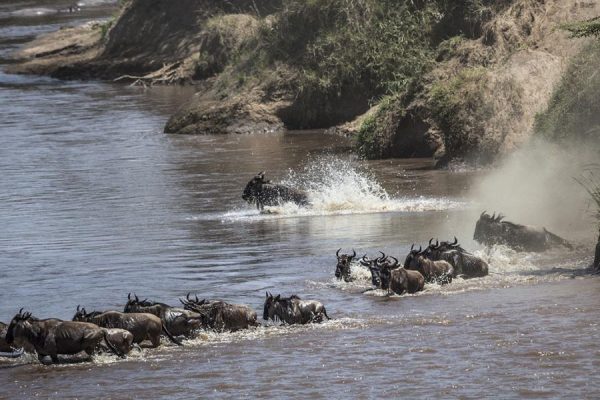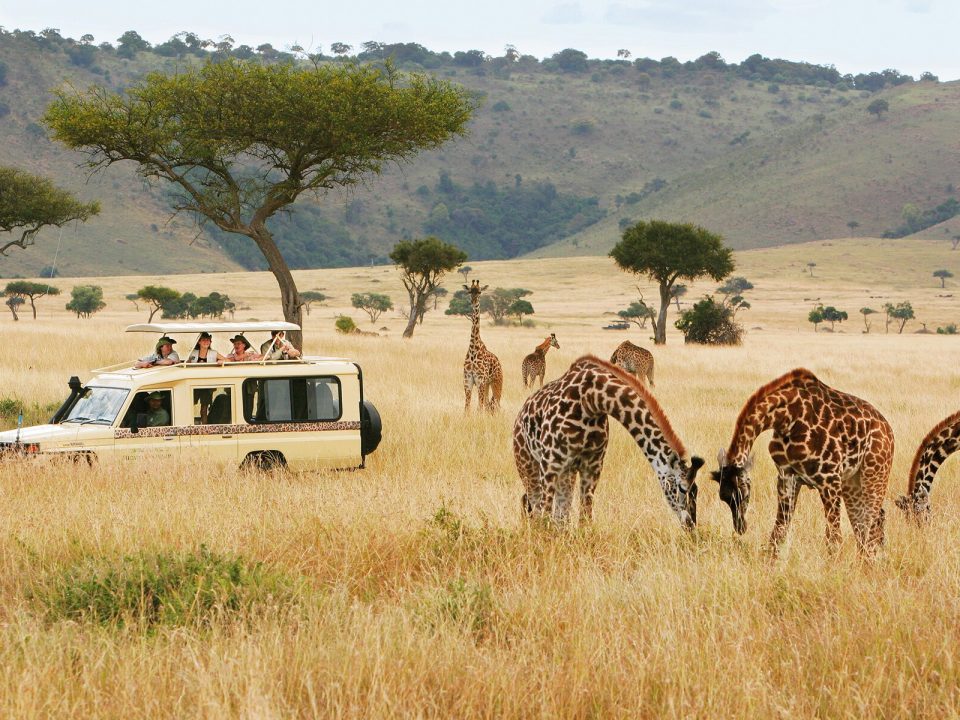
Kenya Safari Packages
October 10, 2021
How to Get to Volcanoes
October 14, 2021
Witness the Great Wildebeest Migration
The Wildebeest Migration Safari Packages in Tanzania And Kenya
The Wildebeest Migration Safari Packages in Tanzania And Kenya. A Complete Guide To Great Wildebeest Migration Kenya (Masai Mara) is the largest migration of animals in the world usually referred to as the wildlife world cup happening year, in the wildebeest migration more than 2 million wildebeests accompanied by large numbers of zebras, Grant’s gazelles, Thompson’s gazelles, elands and impalas moving around the Maasai Mara –Serengeti ecosystem composed of Serengeti national park in Tanzania and Maasai Mara national reserve found in Kenya in a clockwise direction.
The animals participating in the wildebeest migration move in large herds with up to 1,000 animals per kilometers, the greater columns of wildebeests can be seen from the space. The migrating herds move in a constant cycle in search of nutritious grass and water and they are guided by survival instinct, as they move each wildebeest covers 800 to 1,000 kilometers on its individual journey along age-old migration routes.
Great wildebeest migration crossing the Mara River between Masai Mara and Serengeti [Kenya-Tanzania]
Our Favourite Migration Safaris
East Africa Migration Safari
This East Africa Migration Safari, the big game safari will be the trip of a lifetime, taking you 13 days through some of the most renowned and fruitful reserves in Tanzania and Kenya. Visit the savannah grasslands of Serengeti National Park, the must-see Masai Mara National Reserve, and the wildlife-packed Ngorongoro Crater to search for the Big Five and other savannah creatures.
The Great Wildebeest Migration Journey Unpacked
The journey commences in the southern plains of Tanzania’s Serengeti National Park in December, coinciding with the onset of the rainy season. During this period, a substantial number of wildebeest are born, and as the herds replenish, they commence their movement towards the west and then north in search of more fertile grazing grounds. By July, the herds have arrived at the Grumeti River in the Serengeti and the Mara River, which acts as a natural boundary between Tanzania and Kenya. These river crossings are highly captivating spectacles, as the wildebeest face formidable currents and the presence of lurking crocodiles. Following the successful crossing of the Mara River, the herds spend a period of time in the abundant plains of the Maasai Mara National Reserve before returning to the Serengeti to complete their migratory cycle.
When to Go: Timing Your Great Wildebeest Migration Safari
While you can witness the Great Migration in Tanzania and Kenya – Africa at any time of year, your priorities will determine the optimal time to do so.
- Calving Season (Late January to March): The southern Serengeti bears witness to numerous spectacular predator-prey interactions during this time because it is when the majority of wildebeest calves are born.
- Moving North (April – May): The next stop for the herds is the Serengeti Western Corridor, where the terrain is flatter and grassier.
- Grumeti River Crossing (June – July): At this period, the zebras and wildebeests are making their treacherous way across the Grumeti River.
- Mara River Crossing (July – August): As the herds forge ahead through crocodile-infested waters, this may be the most breathtaking moment to see the Great Migration.
- Grazing in the Maasai Mara (September – October): The Maasai Mara in Kenya is home to an abundance of grasses, which the wildebeest and zebras happily exploit.
- Back to Tanzania (November – December): As the southern sky returns to its rainy season, the migratory animals resume their lengthy journey north to Tanzania to breed.
Greatest Wildebeest Migration
While moving the herds separate into 3 groups and each group has different grass-eating habits, the first group eats the top of the tallest grass, the second group eats away the medium–height grass, and the last group eats the remaining grass, and when the grass is completely eaten they move on. Up to today, it is very unclear how the wildebeests know the right way to go but it’s believed their journey is dictated by the response of the migrating herds to weather (the herds follow the rains and the growth of new grass). Though there is no solid proof, some scientists believe the animals’ movement is due to their reaction to the lightning and thunderstorms in a distance. It has also been suggested that the wildebeests can locate the rain more than 50 kilometers away.
Wildebeest migration in Kenya takes place in Masai Mara national reserve the most safari wildlife destination in Kenya, covering an area of 1,510 square meters Maasai Mara national reserve is located in the Rift Valley Province near Narok Town
Wildebeest Migration Route: Month By Month
August – November
From August – November is the only period of the year when the Great Wildebeest Migration in Maasai Mara National Reserve Kenya, the migrating herds enter Kenya from Tanzania’s Serengeti national park using Mara River in what is termed as “the Mara crossing”.
Mara River crossing
Mara River crossing is the most exciting, terrifying, and deadly episode of the great wildebeest migration as thousands of herds (wildebeests, zebras, Thomson, and grant’s gazelles) cross over from Serengeti national park to the plains of Maasai Mara national reserve. As they cross, the animals face-off with the deadly crocodiles in the waters of Mara River which are ready with their sharp teeth to feast on the herds. It is believed that a quarter of the migrating herds survive the deadly cross and after crossing the survivors also face off with predators waiting on the banks of the river that is lions, cheetahs, leopards, and African dogs.
Wildebeest Migration Kenya
Before crossing, the migrating herds arrive in the areas of Mara River in Tanzania side which is the northern region of Serengeti national park in the middle of June and this is said to be the second-largest concentration of the migration. While crossing it is believed that a quarter of the total animals participating in the wildebeest migration across the Mara river to enter Maasai Mara national reserve and others stay in Serengeti national park, but again they also later cross the river multiple times though their crossing is not as deadly as the first crossing.
The migration stays in Kenya’s wildebeest migration until November when the herds move southwards to the Ndutu plains.
Best Time to witness the Wildebeest Migration in Kenya
Wildebeest migration in Kenya is best witnessed from July to October, this period is the peak season for wildebeest migration safaris in Kenya as it is the period when the dramatic river crossing takes place as millions of wildebeests, hundreds of zebras, and grant’s gazelles cross from Serengeti national park to Maasai Mara national reserve.
In this period you will watch the most dangerous and dramatic season of the wildebeest migration as the migrating herd’s faceoff with crocodiles in the Mara River and predators such as lions, leopards, and cheetahs on the banks of the river waiting to feast on the herds (wildebeests, zebras, and gazelles).
Once the herds reach the plains of Maasai Mara national reserve scatter to various regions of the reserve looking for green pastures to feed on an ad in October the herds make their way back south to Serengeti national park once the grasses in Maasai Mara national reserve are depleted.
Wildebeest crossings, River Mara, Northern Serengeti
Where to stay in Kenya during the wildebeest migration
While on wildebeest migration in Kenya there are a number of permanent and seasonal lodges you can get to stay at and these include Royal Mara Safari Lodge, Kichwa Tembo Camp, Kicheche Mara Camp, Little Governor’s camp, Keekorok Lodge,





